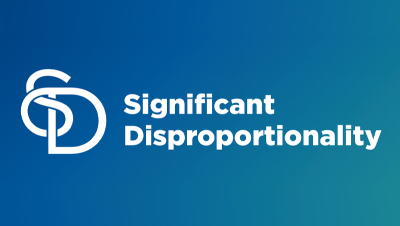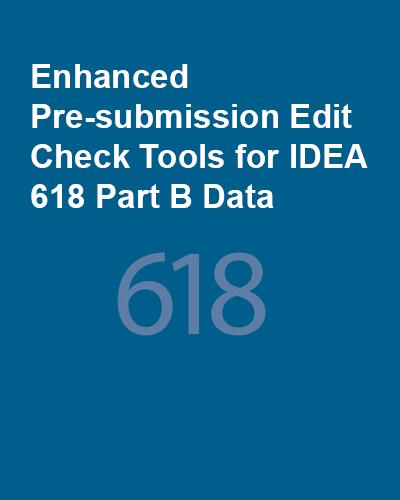
Resource Library
Guides. Briefs. Toolkits. Quick reference information. IDC and its partners created these data quality resources to help states better prepare to address their existing or emerging IDEA data quality needs. Use our search and filtering tools to navigate the library.
Resources 1 - 7 of 12
Format: Guides and Briefs
The Assessment Data Journey: Are We There Yet?Data for Part B Indicator 3 follow a long and complicated process that begins when a student is registered as a test taker in a state assessment system and ends with public reporting via the SPP/APR. Multiple factors are involved in this process, and regular and ongoing communication and collaboration among the various people involved can make this process easier. This suite of four resources can help states with the work. The interactive infographic provides general information about the process for a typical state.
Format: Toolkits
Success Gaps Toolkit: Addressing Equity, Inclusion, and OpportunityThe Success Gaps Toolkit presents a process for using data and the Success Gap Rubric to identify root causes of gaps between groups of children in districts or schools. These success gaps occur when the education system is not meeting the needs of all groups of children and outcomes for some groups are different than outcomes for most groups. The toolkit, with its process and materials, provides a manageable and defined way for districts or schools to identify success gaps that are present and their root causes and then make a plan for addressing the gaps. The success gaps may be the graduation rate of students who are English learners compared to the rate of all other children, the out-of-school suspension rate of children who are Black compared to the rate of all other children, the identification of children who are Hispanic as children with specific learning disabilities compared to the identification of all other children, and other gaps.
Format: Guides and Briefs
Statewide Assessment: Indicator 3 Measurement Changes From FFY 2019 to FFY 2020–2025This resource offers a side-by-side comparison of the SPP/APR Part B indicator measurement tables for FFY 2019 and FFY 2020 to highlight new SPP/APR reporting requirements and measurement changes to Indicator 3. The majority of students with disabilities participate in regular statewide assessments, and a small percentage of students with the most significant disabilities participate in alternate assessments. In FFY 2020, OSEP requires states to disaggregate statewide assessment results for these two groups of students with disabilities (i.e., those who participate in the regular assessment and those who participate in the alternate assessment). OSEP also requires states to calculate a “proficiency rate gap” between students with and without disabilities who participate in the regular statewide assessment.
Format: Quick Reference
Significant Disproportionality ResourcesThe Equity in IDEA regulations require states to determine annually if local education agencies (LEAs) are identified with significant disproportionality. The regulations outline specific requirements related to methods for identifying LEAs and activities the LEAs must complete after they are identified. These significant disproportionality resources can assist states with implementing these requirements and supporting LEAs through the process of meeting the requirements.
Format: Applications and Spreadsheets
SEA Edit Check and Data Display Tools for IDEA 618 Part B DataIDC presents the SEA Edit Check and Data Display Tools for IDEA 618 Part B Data to help states prepare their Part B data submissions. States can use these tools to review the contents of their IDEA 618 EDFacts Part B personnel, exiting, discipline and child count and educational environment data for children ages 3–5 (FS089) and students ages 6–21 (FS002) prior to submission to the EDFacts Submission System or ESS. The tools apply edit checks and identify potential errors in subtotals or totals in the data files. In addition, the tools provide user-friendly summaries of the 618 data. The tools are enhanced versions of the SEA Edit Check and Data Display Tools for personnel, exiting, discipline, and child count and educational environment data. The main difference is the enhanced edit check tools require states to directly copy and paste the EDFacts data files they will submit to ESS as opposed to manually entering data into an Excel file in a format that is different than the one required for submission to ESS.
Format: Guides and Briefs
Measuring Significant Discrepancy: An Indicator B4 Technical Assistance GuideThe TA guide describes the methods a state might use to appropriately determine which of its districts has a significant discrepancy (including a significant discrepancy by race or ethnicity) in the rates of out-of-school suspensions and expulsions totaling greater than 10 days for children with disabilities.
Format: Guides and Briefs
Examining Representation and Identification: Over, Under, or Both?Significant disproportionality with regard to identifying children as children with disabilities or as children with specific disabilities is, by definition, overrepresentation. This resource defines overrepresentation and three related terms: over-identification, under-identification, and underrepresentation. States can use this resource, in conjunction with the Success Gaps Toolkit to help identify and address the factors contributing to significant disproportionality (i.e., overrepresentation) within school districts.








